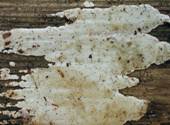Internal pore fungi (Antrodia spp.)
After dry rot and brown cellar rot, internal pore fungi are the most common wood destroyers in buildings, but also attack wood used outdoors with earth contact.
White internal pore fungi prefer coniferous wood, but also attack deciduous wood, causing brown rot. In comparison to dry and brown cellar rot, these fungi require higher wood moistures.
What do internal pore fungi look like?
The fruiting bodies are white and turn yellowish to pink when they get older, depending on the species. They lie on the wood like thin cork-like skins or tiny cushions. The pores are visible to the naked eye and vary from round to angular in shape, giving them a very striking appearance.
The mycelium is white and fluffy and, when young, similar to that of dry rot. The fungi form white strands, which can be as thick as sewing garn, with which they can overgrow wood-free substrates and grow through masonry.
What can be done to combat infestation?
Active infestation by white internal pore fungi must always be combated thoroughly. Fungal determination and assessment of the current infestation should always be carried out by an expert.
The basis for the curative treatment of fungal infestation is the wood preservation standard DIN 68800 part 4 " Wood preservation; measures for the eradication of fungi and insects”.

